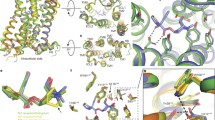Summary
We have characterised the muscarinic receptor subtypes found in human skin fibroblasts and compared binding levels in cell lines from members of the Alzheimer's disease family with the Swedish amyloid precursor protein (APP) 670/671 mutation. Binding studies with [3H] quinuclidinyl benzilate ([3H]QNB) and the M2/M4 selective antagonist [3H](±)-5,11-dihydro-11-{[(2-[(di-propylamino)methyl]-1-piperidinyl}ethyl)amino]carbonyl}-6H-pyrido(2,3-b)(1,4) benzodiazepine-6-one ([3H]AF-DX 384) revealed the presence of a single population of muscarinic receptors on lysed fibroblast membranes. [3H]QNB binding was displaced by a number of selective muscarinic ligands with a rank order of potency: atropine>himbacine>methoctramine>(±)-p-fluoro-hexahydro-sila-difenidol hydrochloride>pirenzepine>muscarinic-toxin-3. APP 670/671 mutation carrying cell lines showed 25–35% lower levels of muscarinic receptors labelled with [3H]QNB, [3H]N-methyl scopolamine and [3H]AF-DX 384, compared to controls. This difference was not statistically significant due to large individual variation. It is concluded that muscarinic receptors on adult skin fibroblasts are predominantly of the M2 subtype. Since these cells do not possess M1 and M3 receptor subtypes, they are unlikely to provide a good model for studying muscarinic receptor regulation of APP processing.
Similar content being viewed by others
References
Adem A, Nordberg A, Bucht G, Winblad B (1986a) Extraneural cholinergic markers in Alzheimer's and Parkinson's disease. Prog Neuropsychopharmacol Biol Psychiatry 10: 247–257
Adem A, Nordberg A, Slanina P (1986b) A muscarinic receptor type in human lymphocytes: a comparision of3H-QNB binding to intact lymphocytes and lysed lymphocyte membranes. Life Sci 38: 1359–1368
Adler MJ, Coronel C, Shelton E, Seegmiller JE, Dewji NN (1991) Increased gene expression of Alzheimer disease β-amyloid precursor protein in senescent cultured fibroblasts. Proc Natl Acad Sci USA 88: 16–20
Balin AK, Baker AC, Leong IC, Blass JP (1988) Normal replicative lifespan of Alzheimer skin fibroblasts. Neurobiol Aging 9: 195–198
Bartha E, Szelényi J, Szilágyi K, Venter V, Thu Ha NT, Páldi-Haris P, Hollán S (1987) Altered lymphocyte acetylcholinesterase activity in patients with senile dementia. Neurosci Lett 79: 190–194
Buxbaum JD, Oishi M, Chen HI, Pinkas-Kramarski R, Jaffe EA, Gandy SE, Greengard P (1992) Cholinergic agonists and interleukin 1 regulate processing and secretion of the Alzheimer β/A4 amyloid protein precursor. Proc Natl Acad Sci USA 89: 10075–10078
Citron M, Vigo-Pelfrey C, Teplow DB, Miller C, Schenk D, Johnston J, Winblad B, Venizelos N, Lannfelt L, Selkoe DJ (1994) Excessive production of amyloid β-protein by peripheral cells of symptomatic and presymptomatic patients carrying the Swedish familial Alzheimer disease mutation. Proc Natl Acad Sci USA 91: 11993–11997
Dörje F, Wess J, Lambrecht G, Tacke R, Mutschler E, Brann MR (1991) Antagonist binding profiles of five cloned human muscarinic receptor subtypes. J Pharmacol Exp Ther 256: 727–733
Ferrero P, Rocca P, Eva C, Benna P, Rebaudengo N, Ravizza L, Genazzani E, Bergamasco B (1991) An analysis of lymphocyte3H-N-methyl-scopolamine binding in neurological patients. Evidence of altered binding in Alzheimer's disease. Brain 144:1759–1770
Glenner GG, Wong CW (1984) Alzheimer's disease: initial report of the purification and characterization of a novel cerebrovascular amyloid protein. Biochem Biophys Res Comm 120: 885–890
Haslam RJ, Goldstein S (1974) Adenosine 3′:5′-cyclic monophosphate in young and senescent human fibroblasts during growth and stationary phase in vitro. Biochem J 144: 253–263
Huang H-M, Gibson GE (1993) Altered β-adrenergic receptor-stimulated cAMP formation in cultured skin fibroblasts from Alzheimer donors. J Biol Chem 268: 14616–14621
Johnston JA, Cowburn RF, Norgren S, Wiehager B, Venizelos N, Winblad B, Vigo-Pelfrey C, Schenk D, Lannfelt L, O'Neill C (1994) Increased β-amyloid release and levels of amyloid precursor protein (APP) in fibroblast cell lines from family members with the Swedish Alzheimer's disease APP670/671 mutation. FEBS Lett 354: 274–278
Karlsson E, Jolkkonen M, Satyapan N, Adem A, Kumlin E, Hellman U, Wernstedt C (1994) Protein toxins that bind to muscarinic acetylcholine receptors. Ann NY Acad Sci 170: 153–161
Kelsoe JR Jr, Gillin JC, Janowsky DS, Brown JH, Risch SC, Lumkin B (1986) Specific [3H]-N-methyl scopolamine binding without cholinergic function in cultured adult skin fibroblasts. Life Sci 38: 1399–1408
Kessler JA (1987) Deficiency of a cholinergic differentiating factor in fibroblasts of patients with Alzheimer's disease. Ann Neurol 21: 95–98
Khatoon S, Grundke-Iqbal I, Iqbal K (1992) Brain levels of microtubule-associated protein τ are elevated in Alzheimer's disease: a radio-immuno-slot-blot assay for nanograms of the protein. J Neurochem 59: 750–753
Lowry OH, Rosebrough NJ, Farr AL, Randall RJ (1951) Protein measurement with the Folin phenol reagent. J Biol Chem 193: 265–275
McCoy KR, Mullins RD, Newcomb TG, Ng GM, Pavlínková G, Polinsky RJ, Nee LE, Sisken JE (1993) Serum- and bradykinin-induced calcium transients in familial Alzheimer's fibroblasts. Neurobiol Aging 14: 447–455
Mullan M, Crawford F, Axelman K, Houlden H, Lilius L, Winblad B, Lannfelt L (1992) A pathogenic mutation for probable Alzheimer's disease in the APP gene at the N-terminus of β-amyloid. Nature Genet 1: 345–347
Munson PJ, Rodbard D (1980) LIGAND: a versatile computerised approach for characterisation of ligand binding systems. Anal Biochem 107: 220–239
Munson R Jr, Westermark B, Glaser L (1979) Tetrodotoxin-sensitive sodium channels in normal human fibroblasts and normal human glia-like cells. Proc Natl Acad Sci USA 76: 6425–6429
Nadi NS, Nurnberger JI Jr, Gershon ES (1984) Muscarinic cholinergic receptors on skin fibroblasts in familial affective disorder. N Engl J Med 311: 225–230
Nitsch RM, Slack BE, Wurtman RJ, Growdon JH (1992) Release of Alzheimer amyloid precursor derivates stimulated by activation of muscarinic acetylcholine receptors. Science 258: 304–307
Peterson C, Gibson GE, Blass JP (1985) Altered calcium uptake in cultured skin fibroblasts from patients with Alzheimer's disease. N Engl J Med 312: 1063–1065
Peterson C, Goldman JE (1986) Alterations in calcium content and biochemical processes in cultured skin fibroblasts from aged and Alzheimer donors. Proc Natl Acad Sci USA 83: 2758–2762
Peterson C, Ratan RR, Shelanski ML, Goldman JE (1988) Altered response of fibroblasts from aged and Alzheimer donors to drugs that elevate cytosolic free calcium. Neurobiol Aging 9: 261–266
Riker DK, Roth RH, Breakefield XO (1981) High-affinity [3H]choline accumulation in cultured human skin fibroblasts. J Neurochem 36: 746–752
Schwartz JP, Breakefield XO (1980) Altered nerve growth factor in fibroblasts from patients with familial dysautonomia. Proc Natl Acad Sci USA 77: 1154–1158
Tesco G, Vergelli M, Amaducci L, Sorbi S (1993) Growth properties of familial Alzheimer skin fibroblasts during in vitro aging. Exp Gerontol 28: 51–58
Van Riper DA, Absher MP, Lenox RH (1985) Muscarinic receptors on intact human fibroblasts. Absence of receptor activity in adult skin cells. J Clin Invest 76: 882–886
Author information
Authors and Affiliations
Rights and permissions
About this article
Cite this article
Vestling, M., Cowburn, R.F., Venizelos, N. et al. Characterization of muscarinic acetylcholine receptors in cultured adult skin fibroblasts: Effects of the swedish Alzheimer's disease APP 670/671 mutation on binding levels. J Neural Transm Gen Sect 10, 1–10 (1995). https://doi.org/10.1007/BF02256625
Received:
Accepted:
Issue Date:
DOI: https://doi.org/10.1007/BF02256625




